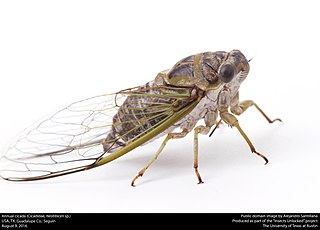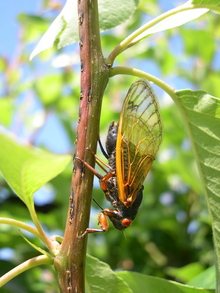
The cicadas are a superfamily, the Cicadoidea, of insects in the order Hemiptera. They are in the suborder Auchenorrhyncha, along with smaller jumping bugs such as leafhoppers and froghoppers. The superfamily is divided into two families, the Tettigarctidae, with two species in Australia, and the Cicadidae, with more than 3,000 species described from around the world; many species remain undescribed. Nearly all of cicada species are annual cicadas with the exception of the few North American periodical cicada species, genus Magicicada, which in a given region emerge en masse every 13 or 17 years.

Brood X, the Great Eastern Brood, is one of 15 broods of periodical cicadas that appear regularly throughout the eastern United States. The brood's first major emergence after 2021 is predicted to occur during 2038.

The term periodical cicada is commonly used to refer to any of the seven species of the genus Magicicada of eastern North America, the 13- and 17-year cicadas. They are called periodical because nearly all individuals in a local population are developmentally synchronized and emerge in the same year. Although they are sometimes called "locusts", this is a misnomer, as cicadas belong to the taxonomic order Hemiptera, suborder Auchenorrhyncha, while locusts are grasshoppers belonging to the order Orthoptera. Magicicada belongs to the cicada tribe Lamotialnini, a group of genera with representatives in Australia, Africa, and Asia, as well as the Americas.

Cicadidae, the true cicadas, is one of two families of cicadas, containing almost all living cicada species with more than 3,200 species worldwide.

Brood XIX is the largest brood of 13-year periodical cicadas, last seen in 2024 across a wide stretch of the southeastern United States. Periodical cicadas are often referred to as "17-year locusts" because most of the known distinct broods have a 17-year life cycle. Brood XIX is one of only three surviving broods with a 13-year cycle. It is also notable because it includes four different 13-year species, one of which was discovered in Brood XIX in 1998 by scientists listening to cicada songs.

Magicicada cassini, known as the 17-year cicada, Cassin's periodical cicada or the dwarf periodical cicada, is a species of periodical cicada. It is endemic to North America. It has a 17-year life cycle but is otherwise indistinguishable from the 13-year periodical cicada Magicicada tredecassini. The two species are usually discussed together as "cassini periodical cicadas" or "cassini-type periodical cicadas." Unlike other periodical cicadas, cassini-type males may synchronize their courting behavior so that tens of thousands of males sing and fly in unison. The species was first reported to the Academy of Natural Sciences of Philadelphia by Margaretta Morris in 1846. In 1852, the species was formally described by J. C. Fisher and given the specific name cassini in honour of John Cassin, an American ornithologist, whose own report was included by Fisher in his publication.

Magicicada septendecim, sometimes called the Pharaoh cicada or the 17-year locust, is native to Canada and the United States and is the largest and most northern species of periodical cicada with a 17-year lifecycle.

Magicicada septendecula is a species of insect in family Cicadidae. It is endemic to the United States.

Predator satiation is an anti-predator adaptation in which prey briefly occur at high population densities, reducing the probability of an individual organism being eaten. When predators are flooded with potential prey, they can consume only a certain amount, so by occurring at high densities prey benefit from a safety in numbers effect. This strategy has evolved in a diverse range of prey, including notably many species of plants, insects, and fish. Predator satiation can be considered a type of refuge from predators.

Massospora cicadina is a fungal pathogen that infects only 13 and 17 year periodical cicadas. Infection results in a "plug" of spores that replaces the end of the cicada's abdomen while it is still alive, leading to infertility, disease transmission, and eventual death of the cicada.
Magicicada neotredecim is the most recently discovered species of periodical cicada. Like all Magicicada species, M. neotredecim has reddish eyes and wing veins and a black dorsal thorax. It has a 13-year life cycle but seems to be most closely related to the 17-year species Magicicada septendecim. Both species are distinguished by broad orange stripes on the abdomen and a unique high-pitched song said to resemble someone calling "weeeee-whoa" or "Pharaoh." They differ only in life cycle length.

Magicicada tredecim is a 13-year species of periodical cicada, closely related to the newly discovered 13-year species Magicicada neotredecim, from which it differs in male song pitch, female song pitch preferences, abdomen color, and mitochondrial DNA. Both M. tredecim and M. neotredecim are closely related to the 17-year species M. septendecim, which was identified by Linnaeus in 1758; these three species are often grouped together under the name decim periodical cicadas.

Decim periodical cicadas is a term used to group three closely related species of periodical cicadas: Magicicada septendecim, Magicicada tredecim, and Magicicada neotredecim. M. septendecim, first described by Carl Linnaeus, has a 17-year life cycle; the name septendecim is Latin for 17. M. tredecim, first described in 1868, has a similar call and appearance but a 13-year life cycle; tredecim is Latin for 13. M. neotredecim, first described in 2000 by Marshall and Cooley in an article in the journal Evolution, is a 13-year species but otherwise much more similar to M. septendecim than to M. tredecim as shown by studies of DNA and abdominal color variation by Chris Simon and colleagues in a companion article in the same journal issue.
David Rothenberg is a professor of philosophy and music at the New Jersey Institute of Technology, with a special interest in animal sounds as music. He is also a composer and jazz musician whose books and recordings reflect a longtime interest in understanding other species such as singing insects by making music with them.

Magicicada tredecassini is a species of periodical cicada endemic to the United States. It has a 13-year lifecycle but is otherwise indistinguishable from the 17-year periodical cicada Magicicada cassini. The two species are usually discussed together as "cassini periodical cicadas" or "cassini-type periodical cicadas." Unlike other periodical cicadas, cassini-type males may synchronize their courting behavior so that tens of thousands of males sing and fly in unison.
Magicicada tredecula is a species of periodical cicada in the family Cicadidae. It is endemic to the United States. As its specific epithet implies, they emerge as adults once every thirteen years.

Tryella is a genus of 14 species of cicada found in Australia and New Guinea. For many years, the members were classified in the genus Abricta. However, recent review of the genus has shown it to be a disparate group of species, and the Australian members moved to other genera. S.M. Moulds conducted a morphological analysis of the genus and found the cicadas split naturally into clades according to biogeographical region. Of the 15 Australian species, the floury baker was the earliest offshoot. Unpublished data confirmed it was quite genetically distant from the other 14 species and so it was classified in a new monotypic genus Aleeta, while the others were placed in the genus Tryella. The genus name is derived from the Ancient Greek tryelis "ladle" and relates to the ladle-shaped uncal lobes of the species in the genus.

Brood XXII is a brood of 13-year periodical cicadas, last seen in 2014 in a geographic region centered on Baton Rouge, Louisiana, as well as other locations in southeast Louisiana and southwest Mississippi. Periodical cicadas are often referred to as "17-year locusts" because most of the known distinct broods have a 17-year life cycle. Brood XXII is one of only three surviving broods with a 13-year cycle. The next emergence of The Baton Rouge Brood is expected in 2027.

Brood V is one of twelve extant broods of periodical cicadas that emerge as adults once every 17 years in North America. They are expected to appear in the eastern half of Ohio, the southwestern corner of Pennsylvania, the upper two-thirds of West Virginia less the Eastern Panhandle, far western Maryland, and some places in Virginia abutting West Virginia. Also included in Brood V is a population that emerges in Suffolk County, Long Island, New York. They last emerged in 2016, and their next appearance will be in 2033.

Brood XXIII is a brood of 13-year periodical cicadas that last emerged in 2015 around the Mississippi River in the states of Louisiana, Mississippi, Arkansas, Tennessee, Missouri, Kentucky, and Illinois. The brood was also seen in Southwestern Indiana and Western Kentucky around the Ohio River, and as far north as Weldon Springs State Park in DeWitt County, Illinois. Brood XXIII is one of three extant periodical cicada broods with a 13-year life cycle, and thus is expected to be seen again in 2028.














